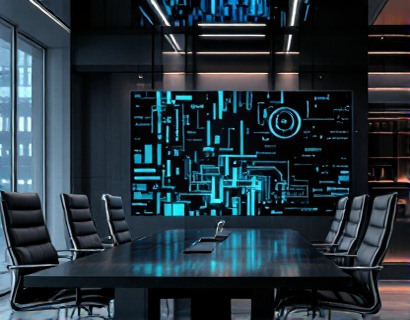Revolutionize Architecture Firm Management: Advanced Software Solutions for Enhanced Efficiency and Collaboration
In the dynamic and competitive world of architecture, managing a firm effectively is as crucial as the creative process itself. The integration of advanced software solutions has emerged as a transformative force, revolutionizing how architecture firms operate. These tools streamline internal processes, enhance user experience, and facilitate seamless collaboration among team members, allowing architects to concentrate on their core expertise: creating innovative and sustainable designs. This article delves into the pivotal role of advanced software in optimizing architecture firm management, focusing on project management, resource allocation, and client interactions.
Streamlining Project Management
Effective project management is the backbone of any successful architecture firm. Advanced software solutions offer robust tools that simplify the planning, execution, and monitoring of projects. These platforms provide a centralized hub where all project-related information is stored and accessible to authorized team members. Key features include:
- Comprehensive project timelines that visualize milestones and deadlines
- Automated task assignments and tracking to ensure accountability
- Real-time progress updates and reporting for stakeholders
- Integration with CAD and BIM tools for seamless design-to-construction workflows
By leveraging these features, architecture firms can reduce the risk of delays, minimize errors, and maintain a clear overview of project statuses. This level of visibility and control enables managers to make informed decisions swiftly, adapting to changes and challenges as they arise.
Optimizing Resource Allocation
Efficient resource allocation is vital for maximizing productivity and minimizing costs. Advanced software solutions offer intelligent tools to manage human and material resources effectively. These tools include:
- Automated scheduling that optimizes team availability and workloads
- Budget tracking and management to ensure financial goals are met
- Inventory management for construction materials and equipment
- Subcontractor management to streamline communication and payment processes
By automating and optimizing these processes, firms can allocate resources more efficiently, reducing waste and ensuring that projects stay within budget and timelines. This not only enhances operational efficiency but also improves client satisfaction through reliable delivery of projects.
Enhancing Client Interactions
Client interaction is a critical aspect of architecture firm management. Advanced software solutions facilitate better communication and collaboration with clients, leading to more satisfactory outcomes. Key features in this area include:
- Client portals for secure access to project information and updates
- Real-time collaboration tools for design reviews and feedback
- Customizable reporting to provide clients with insights into project progress
- Integrated communication channels to streamline client-firm interactions
These tools empower clients to stay informed and engaged throughout the project lifecycle, fostering a sense of partnership and trust. By providing transparent and accessible information, firms can build stronger relationships and enhance client satisfaction.
Improving Internal Collaboration
Collaboration within the firm is as important as collaboration with clients. Advanced software solutions break down silos by providing a unified platform for team members to work together seamlessly. Features that promote internal collaboration include:
- Centralized document management for easy access and version control
- Real-time chat and messaging for instant communication
- Project management boards for visual task tracking and coordination
- Integration with various tools and services to create a cohesive workflow
By fostering a collaborative environment, firms can leverage the collective expertise of their teams, leading to more innovative solutions and higher-quality projects. This internal synergy is crucial for maintaining a competitive edge in the industry.
Boosting Productivity and Efficiency
The overarching benefit of adopting advanced software solutions in architecture firm management is the significant boost in productivity and efficiency. By automating routine tasks, providing real-time insights, and facilitating seamless collaboration, these tools enable teams to focus on what they do best: creating exceptional designs. The time saved from manual processes can be redirected towards creative and strategic activities, driving innovation and growth.
Moreover, the data-driven approach offered by these software solutions allows firms to make informed decisions based on accurate and up-to-date information. This data can be used to identify bottlenecks, optimize workflows, and continuously improve operations. The result is a more agile and responsive organization capable of meeting the evolving demands of the market.
Case Studies and Success Stories
Several architecture firms have already experienced the transformative impact of advanced software solutions. For instance, a mid-sized firm in New York reported a 30% reduction in project delivery time after implementing a comprehensive project management tool. The firm's managers attributed this success to the tool's ability to streamline task assignments and provide real-time project updates. Another firm in San Francisco saw a 25% increase in client satisfaction scores following the introduction of a client portal and real-time collaboration features. These success stories underscore the tangible benefits of adopting advanced software in architecture firm management.
Future Trends and Innovations
The landscape of architecture firm management software is continually evolving, with new innovations on the horizon. One emerging trend is the integration of artificial intelligence (AI) and machine learning (ML) to further enhance automation and decision-making. AI can predict project outcomes, optimize resource allocation, and even assist in design suggestions based on historical data and current trends. Another area of development is the use of virtual and augmented reality (VR/AR) for immersive client presentations and design reviews, providing a more engaging and interactive experience.
As technology advances, the software solutions will become more intuitive, user-friendly, and integrated, offering even greater benefits to architecture firms. The future promises a more connected, efficient, and creative industry, where technology serves as a powerful ally in achieving excellence.
In conclusion, the adoption of advanced software solutions is no longer an option but a necessity for architecture firms aiming to stay competitive and thrive in a rapidly changing environment. By streamlining project management, optimizing resource allocation, enhancing client interactions, and boosting internal collaboration, these tools enable firms to focus on their core mission: delivering exceptional architectural designs that inspire and transform spaces.










































